 |
|
Maritime
Lanka
|
1 Jan 2007
|
|||
| Last modified: 1 Jan 2007 |
|
|
|
|
Beardman jugs were in common use for storing liquids. They were produced along the river Rhine in Germany. They are also known as Bellarmine jugs, after the unpopular Cardinal Bellarmine whom they resembled. The jugs are usually decorated with a bearded face, and sometimes one or more medallions. The small jug on the right was one of two found together amidships; this one was still sealed with its original stopper. (More on the beardman jugs.)
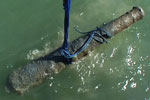 |
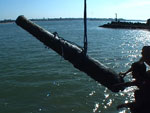 |
 |
There are several cannon on the site, so naturally there are also cannon balls - loose on the site, and with wadding inside the cannon which has been raised. Part of a gun carriage has been found, with rope and tackle which appeared to be associated. One grenade has been found: it is hollow, with a hole 1.7cm in diameter but no associated insert or fuse, and contents which are currently being treated with caution, their age notwithstanding.
Lead shot would have been used for a handheld firearm like a pistol, carbine or musket. It could also be packed in a bag or wooden canister and fired from a cannon. Two canisters of shot have been found on the Avondster, as well as quantities of loose shot. Shot connected with a copper wire has been found, both loose and in the canisters: very effective to cut rigging and wound people.
The remains of a wooden workbox with leather straps suggest that it may have belonged to the constable, who was responsible for all firearms and ammunition on board. Visible in the concretion are a priming pin, used to probe and clean the touchhole of a firearm and to pierce cartridges, the handles of some tongs or scissors, the wooden handle of another tool, a musket ball, and some copper wire.
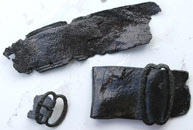 |
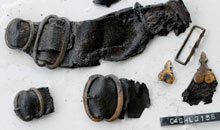 |
 The
remains of leather straps and buckles of different sizes were found in
the same area, and may have belonged to a cartridge belt or similar item. Also
found were the remains of a hobnailed shoe.
The
remains of leather straps and buckles of different sizes were found in
the same area, and may have belonged to a cartridge belt or similar item. Also
found were the remains of a hobnailed shoe.
 |
 Location of finds: (a) Asian jar, (b) small barrel, (c) three ointment jars, (d) two combs, (e) small porcelain vase, (f) rope, (g) lead shot, (h) pulley block. |
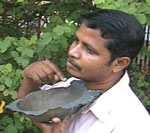 |
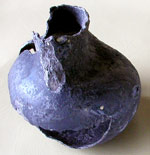 |
Medicine jars were found in the stern. One contained mercury, used in the seventeenth century for treating a whole range of ailments. The contents of another jar are being analysed.
Two combs were found together in the same area (combs were used for removing lice as well as straightening hair). Another find was a barber's bowl, with a recess on the rim to fit the neck during shaving. The ship may well have had a barber-surgeon; this combination of roles was common.
A cupping device was used by pressing the mouth of the heated cup against the skin, creating a vacuum which caused blood or other bodily fluids to rise to the surgace. A similar device was found on the Hollandia (1740s), and they are still commonly used in some parts of Asia.
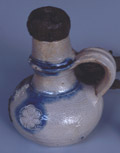
 Blue and white ceramics abound in Galle harbour, mostly low-grade tradeware.
None of the wrecked East Indiamen were carrying ceramics as official cargo,
but many employees of the Dutch East India Company were small-scale traders
on their own account. One porcelain vase was found in the stern of the Avondster,
where the officers lived, and may have been part of such a collection, or for
personal use. This blue and white jar was also found in the stern, with its
stopper still in place, but no detectable contents inside. The pewter flagon
was found nearby,
together with a funnel.
Blue and white ceramics abound in Galle harbour, mostly low-grade tradeware.
None of the wrecked East Indiamen were carrying ceramics as official cargo,
but many employees of the Dutch East India Company were small-scale traders
on their own account. One porcelain vase was found in the stern of the Avondster,
where the officers lived, and may have been part of such a collection, or for
personal use. This blue and white jar was also found in the stern, with its
stopper still in place, but no detectable contents inside. The pewter flagon
was found nearby,
together with a funnel.
(More on the Avondster's ceramics.)

 Faces of pulley block 99/GHL/34; side view. |
A great deal of rope remains, much of it neatly coiled below decks in the bow section, the normal place for storage. The rope is of varying diameters; some is 'sheeted' (bound with a smaller rope for protection; the binding could be replaced when necessary, protecting the main rope). A variety of pulley blocks, deadeyes and other rigging elements have been found, and are helping us to learn more about how the ship may have been rigged.

 Yellow bricks on a wreck site are often the first identifier of a Dutch
ship. The bricks were carried as ballast to Asia, and used there for construction.
They were also used in the galley.
Yellow bricks on a wreck site are often the first identifier of a Dutch
ship. The bricks were carried as ballast to Asia, and used there for construction.
They were also used in the galley.
The circular stone shown underwater is one of the grinding stones, found in different sizes. A slate and associated stone are thought to have been used for the fine grinding of pigments.

 Many
wooden barrels (and the iron concretions left by barrel hoops) have been
found near the galley. Most have been broken, but some have been found intact
and remain on the seabed. One barrel contained a pine resin: pines are
not found in Sri Lanka, but pine resin was mixed with sulphur and fibres such
as animal hair for caulking joints, and also used between layers of planking
for protection against marine organisms. Planks caulked with hair or
a sticky mix containing hair may be seen in this area. Some timbers show traces
of matting or sackcloth. Many of the barrels are surrounded on
the site by wooden branches and offcuts, believed to be dunnage
for packing the spaces between barrels to prevent movement. There was also firewood
near the galley. Coal has been found on the ship: this was brought from
Europe, as the Dutch had found no satisfactory sources in Asia, and was usually
in short supply.
Many
wooden barrels (and the iron concretions left by barrel hoops) have been
found near the galley. Most have been broken, but some have been found intact
and remain on the seabed. One barrel contained a pine resin: pines are
not found in Sri Lanka, but pine resin was mixed with sulphur and fibres such
as animal hair for caulking joints, and also used between layers of planking
for protection against marine organisms. Planks caulked with hair or
a sticky mix containing hair may be seen in this area. Some timbers show traces
of matting or sackcloth. Many of the barrels are surrounded on
the site by wooden branches and offcuts, believed to be dunnage
for packing the spaces between barrels to prevent movement. There was also firewood
near the galley. Coal has been found on the ship: this was brought from
Europe, as the Dutch had found no satisfactory sources in Asia, and was usually
in short supply.
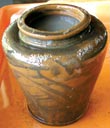 |
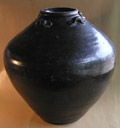 |
Storage jars are always found on ships of this period. They were used as containers for sugar, salt, tea, salted fish, candied fruit, butter, oil, wine, spirits, opium, and even holy water and mud from the Ganges. More prosaically, they were used to store drinking water. Jars like that on the far right are known as martabans (in Dutch, martavan), after Martaban in Burma where they were originally made; the word came to be used for similar jars from all over Asia.
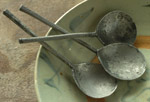 |
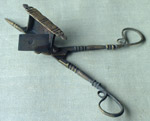 |
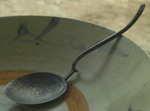 |
Several spoons have been found amidships, close to the galley. Some of the spoons appear to be pewter or tin. The spoon on the right is of copper alloy; it has an interesting shape and balance. Another has a twisted handle.
A candle snuffer and candlestick were found together in a collection area in which artefacts accumulate, outside the starboard side near the stern.
A container to hold measuring weights, apparently of bronze, was found empty; it is similar to one from the Batavia (1629). Measuring weights from such a container had earlier been found separately.
Areca nuts were an important part of the cargo which the Avondster was loading for India, according to the historical records - and they have been found on the wreck site. Areca nuts come from the areca palm, the most graceful and delicate of Sri Lankan palms. Chopped areca nuts, often incorrectly known as betel nuts, are mixed with betel leaf and lime for chewing. The resultant mixture is a mild stimulant, popular in many Asian countries. It stains the mouth and saliva red, and regularly alarms overseas visitors. The Sinhalese were equally disconcerted in 1505 by the Portuguese with their red wine, reporting to the King of Kotte that the foreigners were drinking blood.
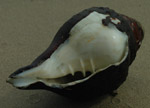
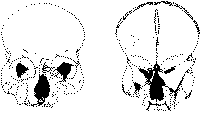 Chank
shells found on the wreck site are of the species Turbinella pyrum
(old generic name Xancus; the Dutch called them chianco). These
shells are used in Hindu and Buddhist rituals, and can be bored for use as musical
instruments in religious ceremonies. Left-handed specimens are particularly
rare and valuable, but the three dozen found so far on the wreck are right-handed.
The Avondster carried chank shells as part of her cargo during 1658.
Chank shells are found in Sri Lankan waters, but have not been recorded around
Galle.(1) It is probable
that the shell came from the ship, especially since chank shells had formed
part of the Avondster's cargo nine months
before sinking.
Chank
shells found on the wreck site are of the species Turbinella pyrum
(old generic name Xancus; the Dutch called them chianco). These
shells are used in Hindu and Buddhist rituals, and can be bored for use as musical
instruments in religious ceremonies. Left-handed specimens are particularly
rare and valuable, but the three dozen found so far on the wreck are right-handed.
The Avondster carried chank shells as part of her cargo during 1658.
Chank shells are found in Sri Lankan waters, but have not been recorded around
Galle.(1) It is probable
that the shell came from the ship, especially since chank shells had formed
part of the Avondster's cargo nine months
before sinking.
A human skull was found in 1999, in what appeared to be an undisturbed C17th layer. This was a surprise, as eye-witness accounts of the shipwreck recorded no casualties. We are now wondering who may have been omitted from the official account - a stowaway, or an early salvage diver? The forensic report(2) is consistent with prolonged immersion, and indicates that the victim was probably male, and about 30-40 years old. His identity remains a mystery.
| Maritime Lanka homepage | The excavation |